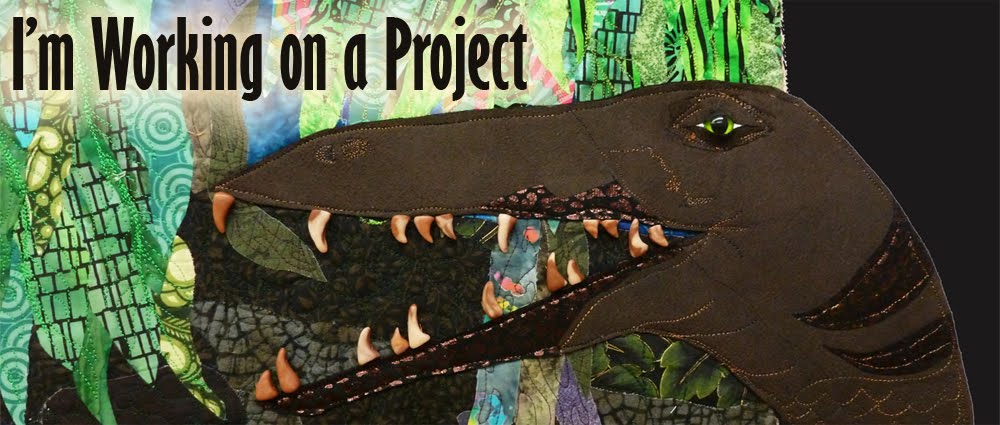I painted six large fabric petal pieces, each one destined to be the front or back of a single petal. The fabric was my usual synthetic polyester-whatever-was sitting around. Some of it was white, some of it was beige, some was heavy weight and some was very lightweight lining, but all synthetic since I wanted to melt it back. I also painted a bunch of peach chiffon for the top section where I wanted it to lighten up. Interestingly, the way some of the fabrics took the paint was differently affected by the plastic I had underneath as I was painting. As a result, in some of the petals there's some pattern in the color due to the crumpled plastic underneath. You can see it a bit in some of the close up pics below. Such fun serendipity!
After the paint dried, I used one painted petal for the back, and then started layering the batting. The bottom half of each petal has a layer of wool batting, then a layer of polyester batting, while the center of each panel has only a single layer of polyester batting, and the top of each petal has no batting at all. I then layered another painted petal on top and then fused down cut organza over the top.
Each petal was heavily machine quilted, and one of the most fun parts for me was picking the thread colors. At first I stuck with blendy colors, but soon started branching out. In the end I think it's the non-blendy colors, the blues, turquoises, and neon yellows, that give some of the depth of color.
The hardest part was actually assembling the whole thing. Of course the quilted petals wouldn't hold any shape alone, so I coated them with several coats of Aleenes fabric stiffener. To get them to stay in place, I pinned the overlapping edges, and stuffed them with crumpled paper. After they dried, I hand stitched the overlapping section of each petal, and also hand stitched the three petals together.
The pocket was a nightmare since I couldn't put it on until all three petals were assembled, but at that point the whole thing was too stiff to sew easily, yet extremely fragile and crushable. Then, since the pocket is about halfway down from the top (because of the odd shape), when I hung it on the wall, the petal tops flopped forward. I finally wound up constructing a sort of skeleton out of yardsticks and stitching small straps to the back to hold the skeleton in place. It now hangs nicely and so far isn't collapsing on the wall. It's about 60" wide, 48" tall, and 8" deep and doesn't in any way get smaller for shipping, so I think I'm going to have to ship it in a mattress box with a bunch of packing material.
 |
| On Dahlias, c. 2016, Shannon Conley, 48" x 60" x 8", photo c. Mike Cox |
 |
| On Dahlias, detail c. 2016, Shannon Conley, 48" x 60" x 8", photo c. Mike Cox |
 |
| On Dahlias, detail c. 2016, Shannon Conley, 48" x 60" x 8", photo c. Mike Cox |
 |
| On Dahlias, detail c. 2016, Shannon Conley, 48" x 60" x 8", photo c. Mike Cox |
I got it "finished" that is, stiffened and stitched together, in time to enter into Quilt National '17, but it took almost two more weeks to get the skeleton, pocket, and slat situation worked out. I just found out last Friday that it didn't get in to Quilt National, but they were kind enough to send out the notices a little earlier than scheduled which meant I had time to enter it into something else with an upcoming deadline. I'm sorry of course that it didn't get in, but for the time being, I'm enjoying having it hanging on the yellow wall under the big window in my studio.
Super super excitingly though, my mom did get a piece into Quilt National (Hooray!), so we'll travel together out for the opening next May.
Finishing this for the QN deadline was a big push for me, and the last three weeks have been really crazy on the personal front, but now I'm back home for a little while and have some time to start focusing on my next thing! Incidentally, if you like dahlias, this is the best instagram account ever.


























